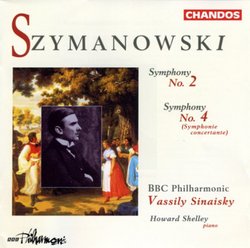| All Artists: Karol Szymanowski, Vassily Sinaisky, BBC Philharmonic Orchestra, Howard Shelley Title: Szymanowski: Symphony no. 2; Symphony No. 4 (Symphonie concertante) Members Wishing: 0 Total Copies: 0 Label: Chandos Release Date: 6/18/1996 Genre: Classical Styles: Forms & Genres, Concertos, Historical Periods, Modern, 20th, & 21st Century, Symphonies Number of Discs: 1 SwapaCD Credits: 1 UPC: 095115947821 |
Search - Karol Szymanowski, Vassily Sinaisky, BBC Philharmonic Orchestra :: Szymanowski: Symphony no. 2; Symphony No. 4 (Symphonie concertante)
 | Karol Szymanowski, Vassily Sinaisky, BBC Philharmonic Orchestra Szymanowski: Symphony no. 2; Symphony No. 4 (Symphonie concertante) Genre: Classical
Karol Szymanowski (1882-1937) is a transitional figure in Polish music. He was born into a musical culture heavily influenced by the great German composers of the 19th century and, of course, Chopin. Szymanowski never qu... more » |
Larger Image |

 Track Listings (6) - Disc #1
Track Listings (6) - Disc #1